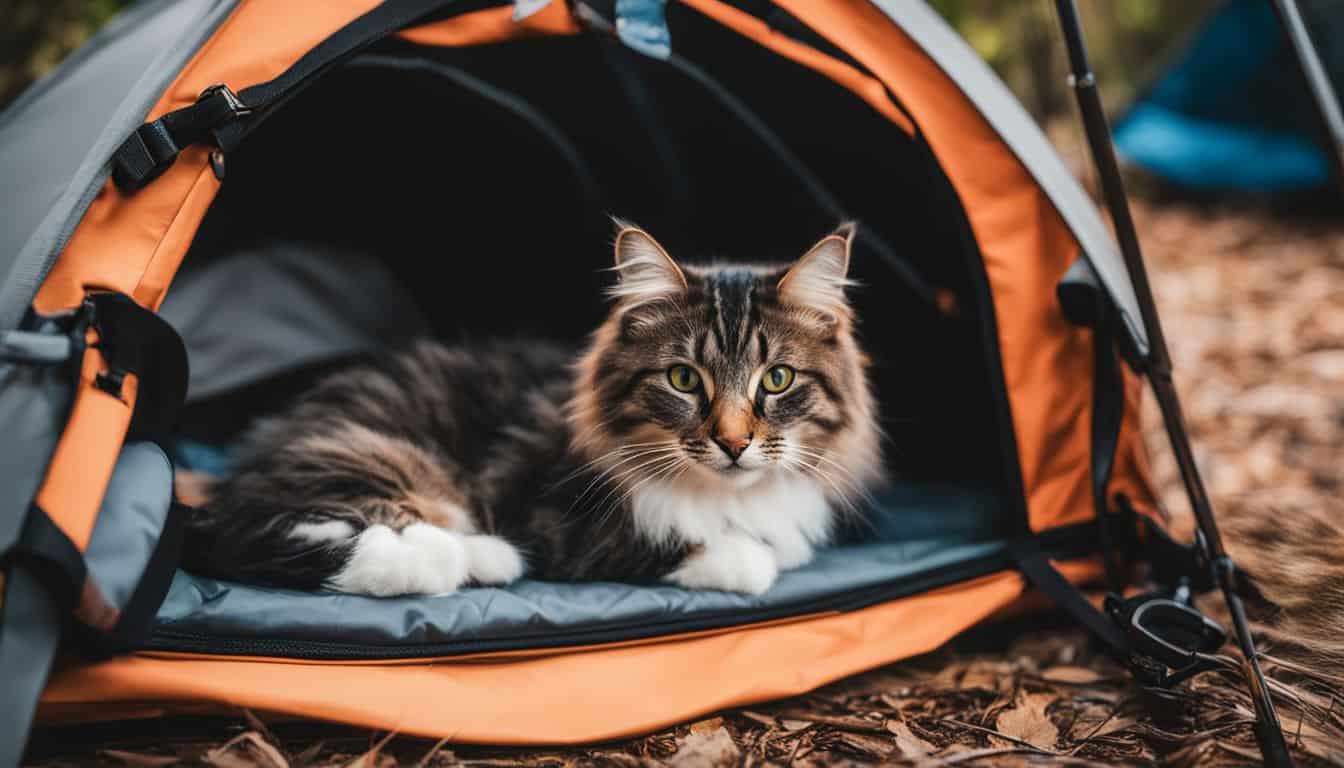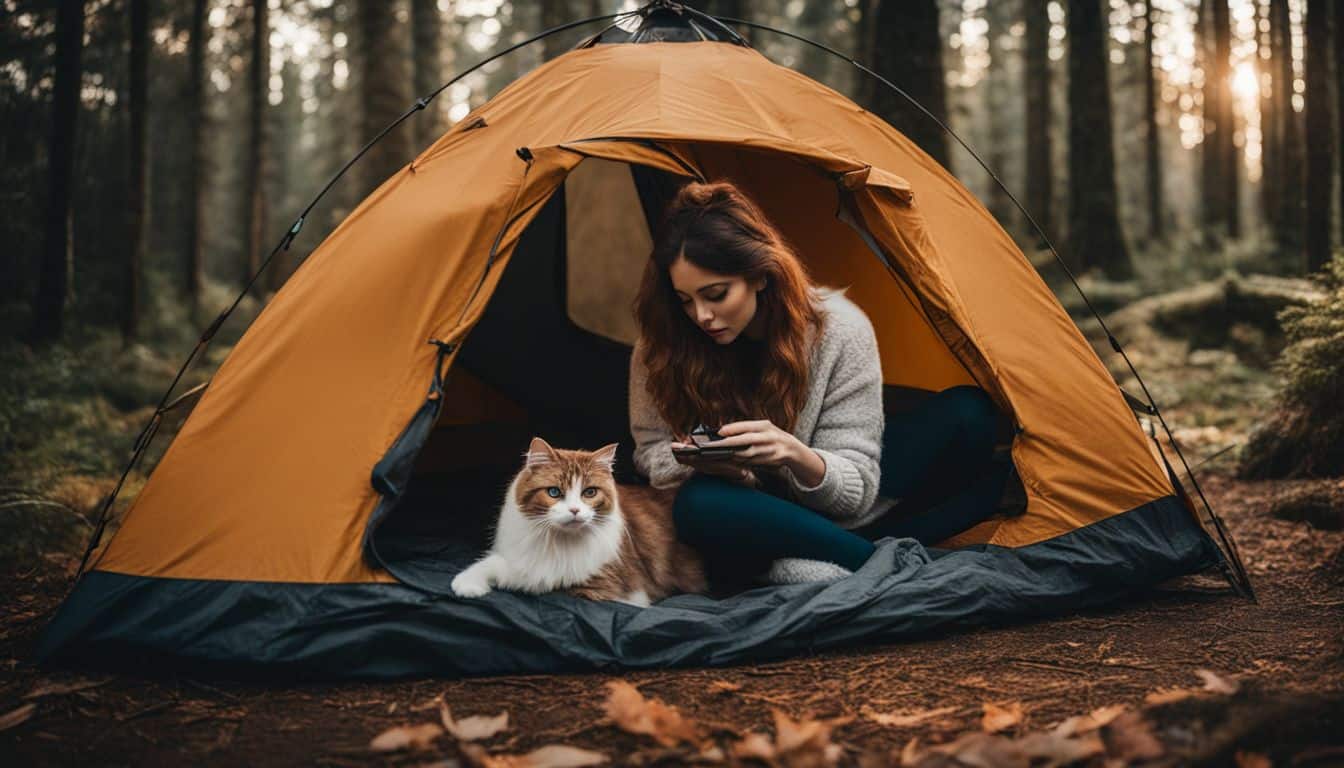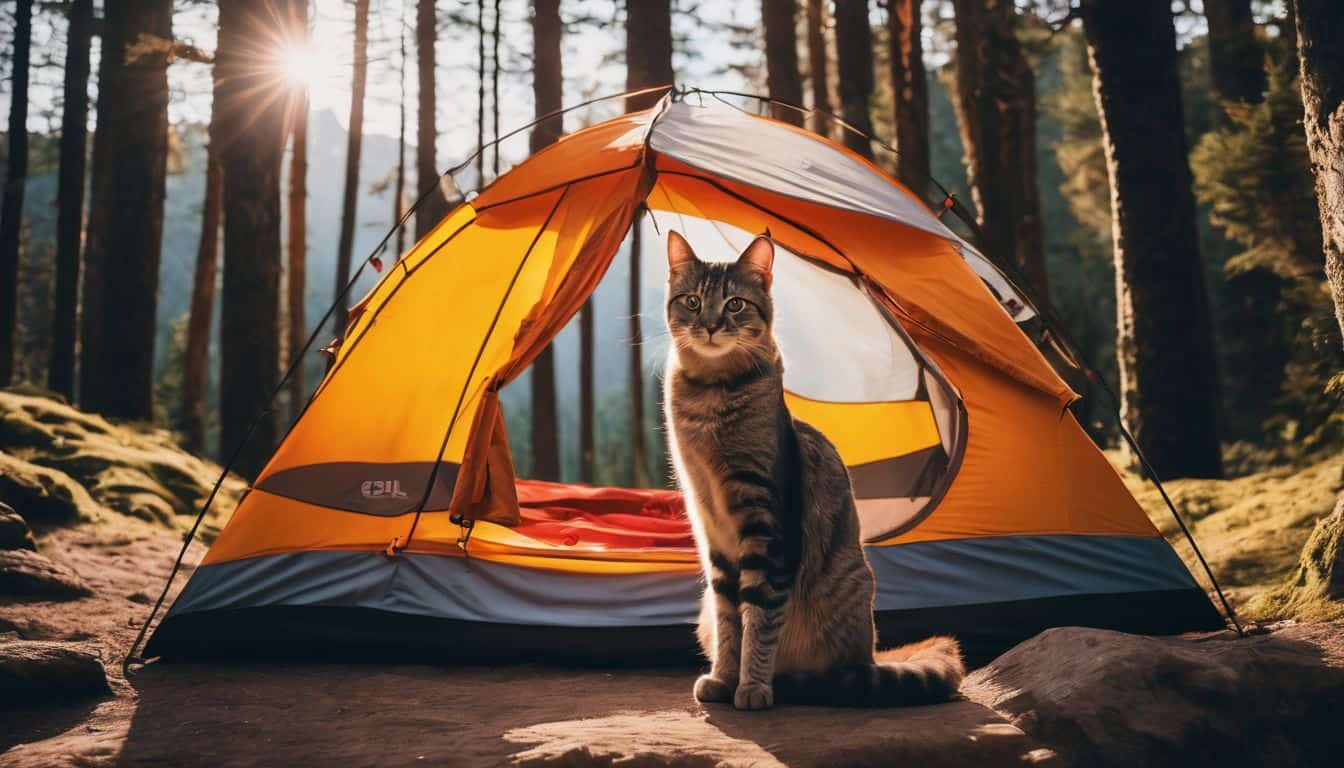Preparing Your Cat for Camping

Before embarking on your camping journey, it’s crucial to prepare your cat for the experience:
Harness and Leash Training
Invest in a secure harness and gradually introduce your cat to leash walking. This is essential for camping with cats safely. Start by letting your cat wear the harness indoors for short periods, gradually increasing the duration. Once comfortable, attach the leash and practice walking in a quiet, enclosed area. Reward your cat with treats and praise to create positive associations with the harness and leash.
Outdoor Exposure
Start with backyard adventures and short trips to build your cat’s confidence in outdoor settings. Begin with brief supervised sessions in a secure outdoor space, allowing your cat to explore at their own pace. Gradually increase the duration and introduce new environments, always ensuring your cat feels safe and can retreat if overwhelmed.
Car Travel Acclimation
Ensure your cat is comfortable with car rides, as this is an important part of car camping with cats. Start with short drives around the block, gradually increasing the duration. Use a secure carrier and consider using calming pheromone sprays or treats to reduce anxiety. Make frequent stops on longer journeys to allow your cat to use the litter box and drink water.
Essential Gear for Cat Camping
Equip yourself with the right cat camping gear for a smooth experience:
Cat-Specific Equipment
- Invest in a sturdy, escape-proof harness and a reflective leash for added visibility.
- Pack a collapsible litter box and cat-friendly, biodegradable litter for easy waste management.
- Use LED collars or light-up tags for nighttime visibility and safety.
Camping Gear Considerations
- Choose a cat-friendly tent with secure zippers and mesh windows for ventilation.
- Bring a small, cozy bed or blanket for your cat’s comfort inside the tent.
- Consider a portable cat enclosure or playpen for supervised outdoor time at the campsite.
Safety and Comfort Items
- Pack a cat-specific first aid kit including items like tweezers for tick removal, antiseptic wipes, and any necessary medications.
- Bring familiar bedding, toys, and scratching posts from home to provide comfort and reduce stress in the new environment.
- Include a recent photo of your cat and proof of vaccinations in case of emergency.
Setting Up a Cat-Safe Campsite
Create a secure environment for your cat:
Tent Setup and Management
Ensure your tent is escape-proof and provides a safe sleeping area. Double-check all zippers and closures, and consider using carabiners for added security. Create a cozy corner with your cat’s familiar bedding and toys. Use a small battery-operated fan for ventilation and to help mask unfamiliar outdoor noises that might startle your cat.
Outdoor Living Space
Consider portable enclosures or long-line setups for supervised exploration. A pop-up mesh enclosure can provide a safe outdoor space for your cat to enjoy fresh air and sunshine. Alternatively, set up a long-line system between trees, allowing your cat to explore while remaining tethered. Always supervise your cat when outside the tent.
Litter Box Placement
Choose discreet, accessible locations for the litter box and practice proper odor control. Place the litter box in a sheltered area away from your sleeping and eating spaces. Use odor-absorbing, biodegradable litter and clean frequently. In bear country, treat cat waste like human waste, following local regulations for disposal.
Camping Activities with Cats
Engage your cat in short hikes, bird watching, or relaxation time in camp. Start with brief, gentle walks on a harness, allowing your cat to set the pace. Set up a comfortable observation spot for bird watching, which can provide mental stimulation. Bring interactive toys for play sessions in camp, reinforcing the bond between you and your cat in this new environment.

Feeding and Hydration
Maintain regular feeding schedules and ensure access to clean water. Practice safe food storage to avoid attracting wildlife. Use sealed containers for cat food and store them with your own food supplies, following campground regulations for wildlife safety. Bring collapsible water bowls and refresh water frequently, especially in warm weather.
Nighttime Routines
Create a comfortable sleeping environment and be prepared to manage nighttime restlessness. Maintain your cat’s usual bedtime routine as much as possible. Bring a small night light to help your cat navigate the tent. Be prepared for potential restlessness due to new sounds and smells; patience and reassurance can help your cat settle.
Safety Precautions
Stay vigilant about wildlife, weather conditions, and have an emergency plan in place. Research local wildlife and potential hazards before your trip. Keep your cat inside the tent at dawn and dusk when predators are most active. Have a plan for severe weather, including a way to quickly secure your cat in case of needed evacuation.
Common Challenges and Solutions
Be prepared to deal with anxiety, scratching behavior, and potential escape attempts. Bring calming aids like pheromone sprays or your cat’s favorite treats. Protect tent floors with extra blankets or tarps to prevent damage from scratching. Always secure the tent when entering or exiting to prevent escapes.
Leave No Trace with Cats
Practice proper waste disposal and minimize your impact on the campsite and wildlife. Scoop and pack out all cat waste, treating it like human waste in terms of disposal. Keep your cat from hunting local wildlife, which can disrupt the ecosystem. Leave your campsite as clean or cleaner than you found it.
Post-Camping Care
After your trip, check your cat for ticks or injuries and help them readjust to home life. Conduct a thorough physical check, paying attention to paws, ears, and under the fur. Allow your cat time to decompress and readjust to home surroundings. Maintain some of the extra attention and play time you shared while camping to ease the transition back to normal routines.
Conclusion
By following these guidelines, you can create a safe and enjoyable camping experience for both you and your feline companion. Remember to start small and gradually build up to longer trips as your cat becomes more comfortable with outdoor adventures.

Leave a Reply